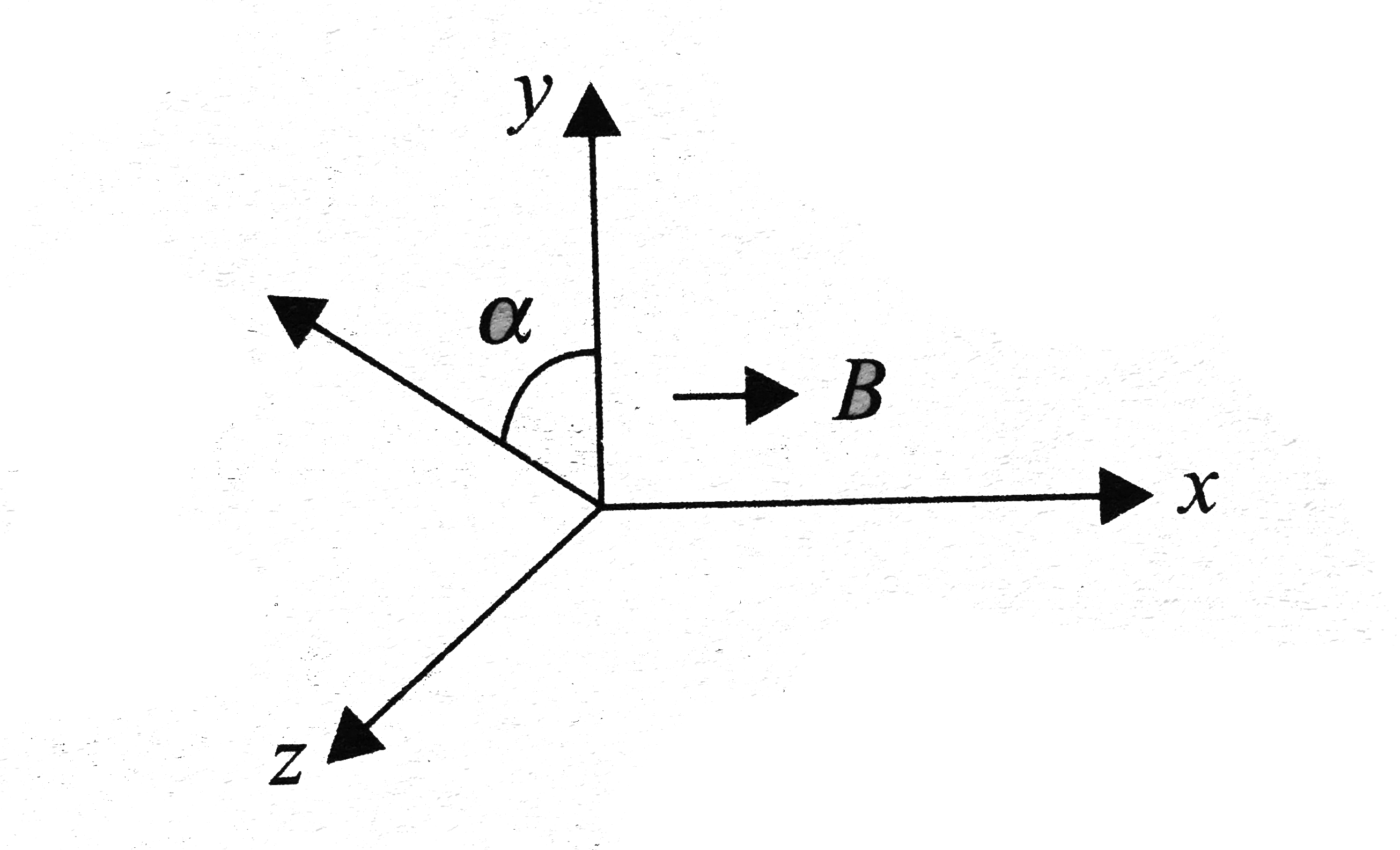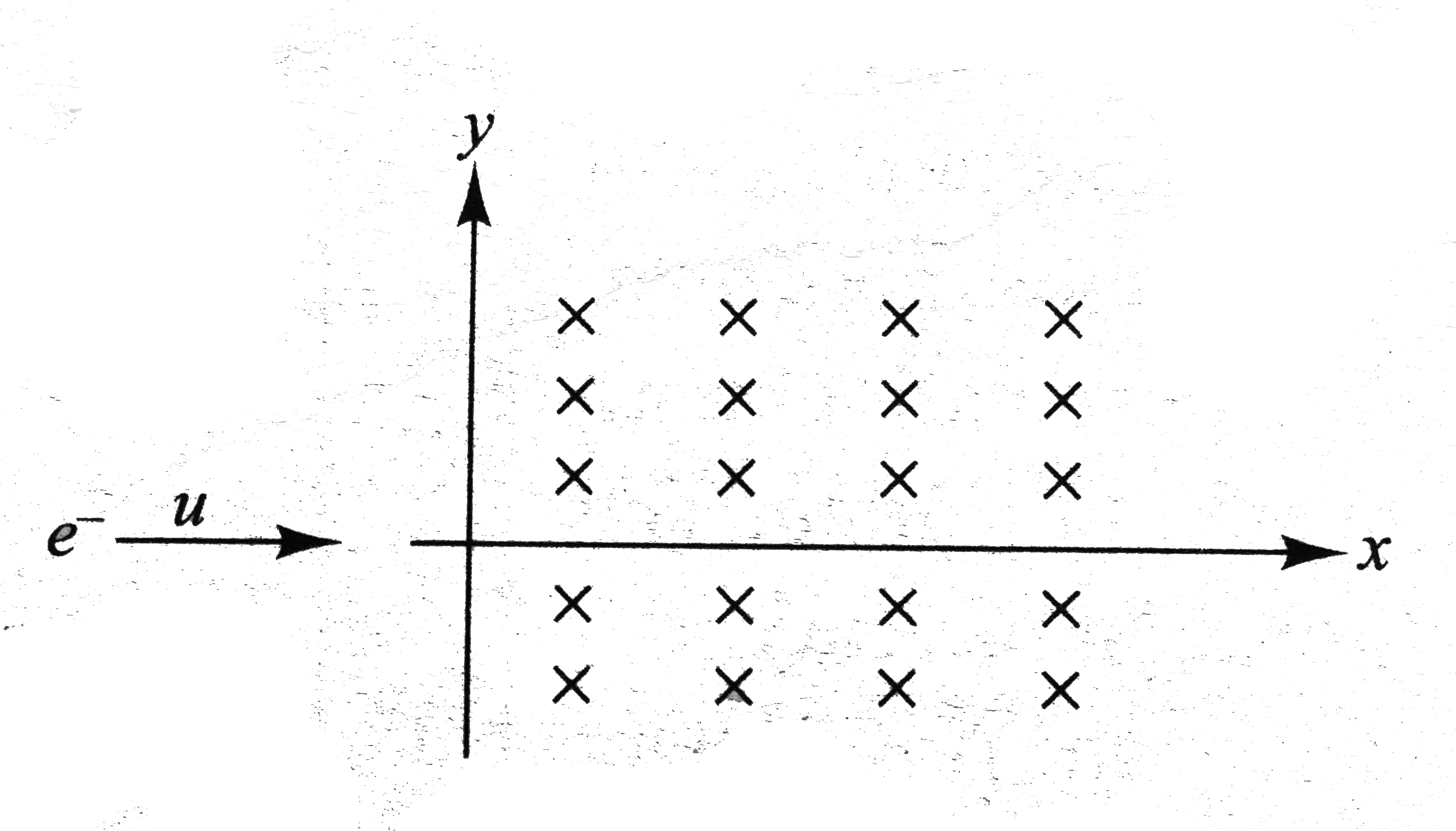An electron enters with a velocity →v=v0ˆi into a cubical region (faces parallel to coordinate planes) in which there are uniform electric and magnetic fields. The orbit of the electron is found to spiral down inside the cube in plane parallel to the x-y plane. Suggest a configuration of fields →E and →B that can lead to it.
To solve the problem, we need to determine the configuration of the electric field →E and the magnetic field →B that allows an electron to spiral down in a plane parallel to the x-y plane when it enters with an initial velocity along the x-axis.
1. Identify the Initial Conditions:
- The electron enters with a velocity →v=v0^i, meaning it is moving along the positive x-direction.
- The electron is negatively charged, with charge q=−e.
2. Determine the Magnetic Force:
- The magnetic force acting on a charged particle moving in a magnetic field is given by the equation:
→FB=q→v×→B
- Since the velocity →v is along the x-axis, the magnetic field →B must be oriented in such a way that the resulting force is perpendicular to both →v and →B.
3. Choose the Direction of the Magnetic Field:
- If we set the magnetic field →B along the positive z-axis, →B=B0^k, we can find the direction of the magnetic force:
→FB=−e(v0^i)×(B0^k)=−ev0B0(^i×^k)=−ev0B0(−^j)=ev0B0^j
- This means the magnetic force →FB acts in the positive y-direction.
4. Determine the Electric Force:
- The electric force on the electron is given by:
→FE=q→E=−e→E
- To have the electron spiral downwards, we need the electric force to act in the negative x-direction. Therefore, we set the electric field →E along the positive x-axis:
→E=E0^i
- The electric force then becomes:
→FE=−eE0^i
5. Combine the Forces:
- The net force acting on the electron will be the sum of the electric and magnetic forces:
→Fnet=→FE+→FB=−eE0^i+ev0B0^j
- The negative x-component of the force will cause the electron to decelerate in the x-direction, while the positive y-component will cause it to move in a circular path in the y-direction.
6. Conclusion:
- The configuration of the fields that leads to the electron spiraling down in the x-y plane is:
→E=E0^i(Electric field along the x-axis)
→B=B0^k(Magnetic field along the z-axis)
- The electron enters with a velocity →v=v0^i, meaning it is moving along the positive x-direction.
- The electron is negatively charged, with charge q=−e.
- The magnetic force acting on a charged particle moving in a magnetic field is given by the equation:
→FB=q→v×→B
- Since the velocity →v is along the x-axis, the magnetic field →B must be oriented in such a way that the resulting force is perpendicular to both →v and →B.
- If we set the magnetic field →B along the positive z-axis, →B=B0^k, we can find the direction of the magnetic force:
→FB=−e(v0^i)×(B0^k)=−ev0B0(^i×^k)=−ev0B0(−^j)=ev0B0^j
- This means the magnetic force →FB acts in the positive y-direction.
- The electric force on the electron is given by:
→FE=q→E=−e→E
- To have the electron spiral downwards, we need the electric force to act in the negative x-direction. Therefore, we set the electric field →E along the positive x-axis:
→E=E0^i
- The electric force then becomes:
→FE=−eE0^i
- The net force acting on the electron will be the sum of the electric and magnetic forces:
→Fnet=→FE+→FB=−eE0^i+ev0B0^j
- The negative x-component of the force will cause the electron to decelerate in the x-direction, while the positive y-component will cause it to move in a circular path in the y-direction.
- The configuration of the fields that leads to the electron spiraling down in the x-y plane is:
→E=E0^i(Electric field along the x-axis)
→B=B0^k(Magnetic field along the z-axis)
Topper's Solved these Questions
- MOVING CHARNGES AND MAGNETISMBOOK - NCERT EXEMPLAR ENGLISHCHAPTER - MOVING CHARNGES AND MAGNETISMEXERCISE - Long Answer Type Questions
7 Videos
- MOVING CHARNGES AND MAGNETISMBOOK - NCERT EXEMPLAR ENGLISHCHAPTER - MOVING CHARNGES AND MAGNETISMEXERCISE - Very Short Answer Type Question
5 Videos
- MAGNETISM AND MATTER BOOK - NCERT EXEMPLAR ENGLISHCHAPTER - MAGNETISM AND MATTER EXERCISE - All Questions
24 Videos
- NUCLEIBOOK - NCERT EXEMPLAR ENGLISHCHAPTER - NUCLEIEXERCISE - Long answer type question
10 Videos
Similar Questions
A cubical region of space is filled with some uniform electric and magnetic fields. An electron enters the cube across one of its faces with velocity →v and a positron enters via opposite face with velocity −→v. At this instant,
View SolutionAn electron projectes with velocity →v=v0ˆi in the electric field →E=E0ˆj. There the path followed by the electron E0.
View Solution
Knowledge Check
A cubical region of space is filled with some uniform electric and magnetic field. An electron enters the cube across one of its faces with velocity v and a positron enters via opposite face with velocity- v. At this instant, which one of the following is not correct?
AThe electric forces on both the particles cause identical acceleration.BThe magnetic forces on both the particles cause equal acceleration.CBoth particles gain or loose energy at the same rate.DThe motion of the centre of mass is determined by B alone.An electron is moving with an initial velocity →v=v0ˆi and is in a magnetic field →B=B0ˆj. Then it's de-Broglie wavelength
Aremains constantBincreases with timeCdecreases with timeDincreases and decreases periodically
What is the net flux of the uniform electric field of the above question through a cube of side 20 cm oriented so that its faces are parallel to the coordinate planes?
View SolutionAn electron is moving with an initial velocity →v=v0ˆi and is in a magnetic field →B=B0ˆj. Then it's de-Broglie wavelength
View SolutionA beam of electrons is moving with uniform velocity in a region having transverse uniform electric and magnetic field of strength. 100 V/m and 0.1 T respectively at right angles to the direction of beam. The velocity of the electrons is
View SolutionIn a region of space, a uniform magnetic field B exists in the x-direction. An electron is fired from the origin with its initial velocity u making an angle α with the y direction in the y-z plane. In the subsequent motion of the electron,

View SolutionAn electron moving with a speed u along the positive x-axis at y=0 enters a region of uniform magnetic field which exists to the right of y-axis. The electron exits from the region after some time with the speed v at coordinate y, then

View SolutionAn electron moving with a speed u along the positive x-axis at y=0 enters a region of uniform magnetic field which exists to the right of y-axis. The electron exits from the region after some time with the speed v at coordinate y, then

View Solution
